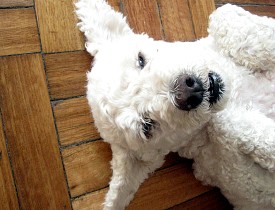Choosing The Right Dog Breed for Your Climate
 Whether you are selecting your first dog or moving to a new location, it is important to know what climate your pup will thrive in. If you live in a climate your dog would not naturally be acclimated to, you may need to make some adjustments for the health of your pet. While it may seem obvious that if a dog has long hair it will fare better in a cold environment, there are several other factors to consider. Dr. Steven Ellis DVM of the Sunderland Animal Hospital in Massachusetts offers good advice on climate and your dog.
Whether you are selecting your first dog or moving to a new location, it is important to know what climate your pup will thrive in. If you live in a climate your dog would not naturally be acclimated to, you may need to make some adjustments for the health of your pet. While it may seem obvious that if a dog has long hair it will fare better in a cold environment, there are several other factors to consider. Dr. Steven Ellis DVM of the Sunderland Animal Hospital in Massachusetts offers good advice on climate and your dog.
If you live in a colder climate
Ellis points out that dog breeds that thrive in colder environments, such as Huskies, Newfoundlands and Retrievers, have a double coat of fur to keep them warm. “Those are the dogs that have been bred for a colder environment. They can take the cold and snow better.”
However, they also have a lot more hair to shed, especially in spring, when the dog loses its undercoat. “You have to have a really good vacuum and be willing to live with a lot of hair floating around your house,” warns Ellis. Ellis tells of a dog owner who always buys an inexpensive vacuum to clean fur off her flooring, but with an extended warranty due to her dog’s shedding. “She says that eventually the motor seizes up or burns out from all the hair.”
If you live in a warmer climate
Ellis mentions that while many people live with air conditioning in Baltimore and other climates that get hot in the summer, some breeds do better in warmer climates, but not necessarily for the reason you might think. Although being a short-haired breed such as a greyhound, Great Dane or dachshund is helpful, the real reason these breeds do better in a hot climate is they do not require a lot of exercise. “Dogs don’t have sweat glands like humans. They pant in order to cool themselves off,” explains Ellis. “One breed of dog that does well with hot weather and more in the way of exercise is the poodle. On the other hand, Great Danes are big couch potatoes.” Other good breeds of dog for warmer climates are terriers and spaniels.
It’s all about the snout
According to Ellis, dogs that have longer noses or snouts fare better in a hot climate, as they can take a greater volume of air in and out more quickly. Flat-faced dogs such as pugs, boxers, and Pekinese have a much harder time in warm weather. Ellis emphasizes that the body mass of your dog doesn’t matter when it comes to higher temperatures, as much as the size of their nose.
Climate and potential skin problems for your dog
If you live in an area that has high humidity, you may not want to have a breed of dog that has wrinkles or folds in its skin. “Wrinkly dogs, like the Shar Pei, can develop skin problems. The skin folds trap moisture and bacteria gets set up, and then infection can set in,” cautions Ellis.
Climate and potential eye disease problems for your dog
If you live in a climate with a lot of sun, or your dog is outdoors often, it may develop pannus. Pannus is an eye condition that primarily affects German Shepherds, but may occur in other breeds as well when there is a high exposure to ultraviolet light. Pannus is a thickening of scar tissue over the cornea and tends to occur as the dog nears middle age, though it can happen earlier. Ellis states that other dogs which tend to be more affected by the possibility of pannus are border collies, dachshunds, greyhounds and Siberian huskies.
Ellis suggests that it’s helpful or necessary for dogs that have or are prone to pannus to wear sunglasses or goggles. In fact, there is a brand specially made for dogs called “Doggles” which can be purchased from your veterinarian or online.
Updated July 4, 2018.
Looking for a Pro? Call us (866) 441-6648

Flooring Average Costs
Flooring Contractors Experiences

Awesome Flooring Replacement After The Wood Literally Rotted Away

How I Chose My Flooring Contractor And Why I’m Glad I Did



